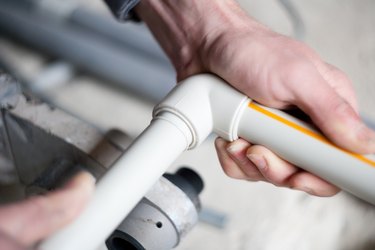
PVC pipes and joint fittings are chemically fused by the PVC's solvent glue, permanently joining the pipes. Because of this, most PVC fittings and pipes can't simply be removed when one springs a leak; instead, they must be cut away. However, when dealing with drain pipes, there are some temporary repairs available that can stop a leak until you're able to troubleshoot the problem.
Turn Off the Water Supply
Video of the Day
Note that these repairs are not intended for pressurized pipes and should be used only as a temporary fix to drain pipes. They'll still require a permanent solution.
Video of the Day
When you first notice a leak in a PVC pipe, you should immediately turn off the water supply at its source to stop further leaking. The water main valve can usually be found in the basement, typically along the front foundation wall nearest the water meter. If you don't have a basement, the valve could be located by the water heater, under the kitchen sink or outside, attached to the house.
Once the supply is shut off, the remaining water will drain from the pipe. You can wrap a rag around the leak to soak up the water and minimize what will drain onto your floor. Placing a bucket underneath may also help.
Seal the Leak Temporarily
Clean the area of the leak with a household cleaner and rag, making sure no particles or dust are left clinging to the pipe. This ensures that any adhesive applied to the area will stick.
You can temporarily seal the leak — if it's small — with rubber and silicone repair tape. This is a heavy-duty tape that stretches and sticks to itself, making it ideal for creating compression when tightly wound. Wrap the tape in a spiral fashion around the leak, making sure to extend well past the area of the leak.
If a tight space makes wrapping the pipe with tape too difficult or even impossible, try PVC repair epoxy. Designed for water repairs, the epoxy comes in putty and liquid forms and adheres to the pipe to temporarily seal the leak. Follow the instructions on the packaging when you apply the epoxy. Usually, you'll need to allow 25 minutes to an hour for the epoxy to set.
Other Repair Options
Fiberglass wrap — a fiberglass cloth coated in resin — activates when dipped in water and adheres to the pipe or joint. Apply the wrap a few inches past the leaking area; it will harden within 10 to 15 minutes. Remember, when handling fiberglass, wear eye protection and gloves, and make sure you're fully clothed in long pants and long sleeves.
If you're in a bind, the leak can, at the very least, be slowed with a piece of rubber and hose clamps. Drape the rubber over the leak and secure it tightly in place with the hose clamps. This should buy enough time to call a plumber. If the leak is in the joint, however, the joint's shape may prevent this method from working effectively.
Remember, these repairs are only temporary — best used to buy time until a more permanent repair can be set. They're handy for getting the initial leak under control. You should, however, contact a plumber for help with a more permanent solution.